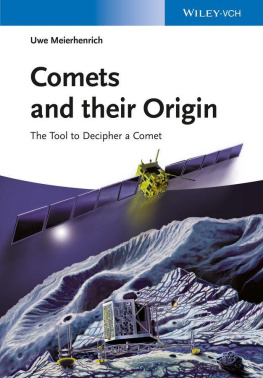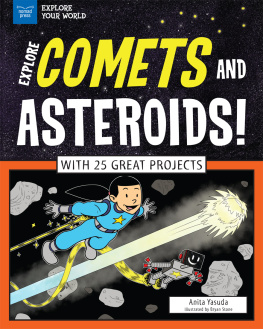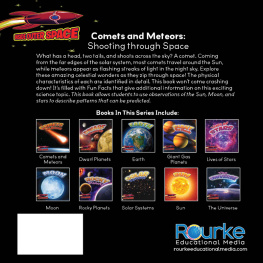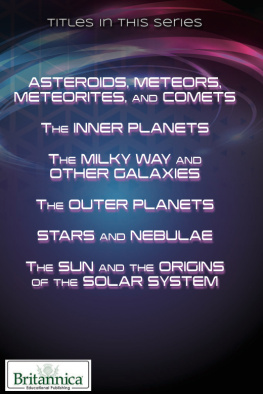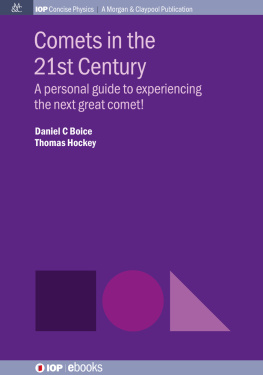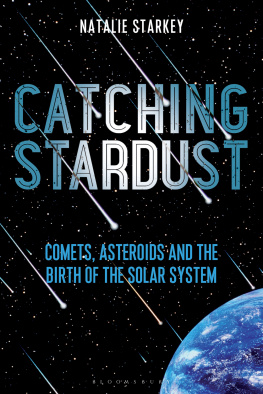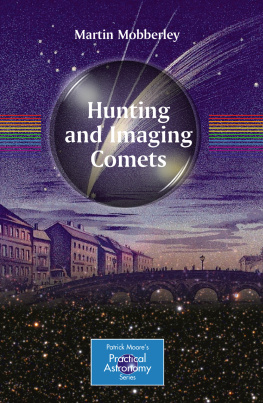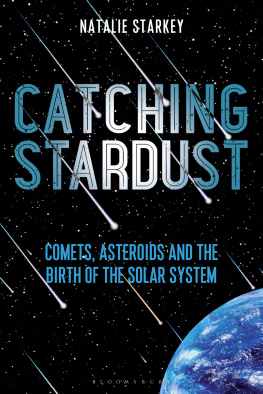Table of Contents
Pages
Guide
List of Illustrations
List of Tables
Related Titles
Jones, B.B.
Discovering the Solar System 2e
2 Edition
2007
ISBN: 978-0-470-01830-9
Also available in digital format.
Shaw, A.M.
Astrochemistry - From Astronomy to Astrobiology
2006
ISBN: 978-0-470-09136-4
Also available in digital format.
March, R.E., Todd, J.F., Hughes, R.J.
Quadrupole Ion Trap Mass Spectrometry, Second Edition
2 Edition
2005
ISBN: 978-0-471-48888-0
Also available in digital formats.
Uwe Meierhenrich
Comets and their Origin
The Tool to Decipher a Comet
Author
Uwe Meierhenrich
Universit Nice Sophia Antipolis
Institut de Chimie de Nice
France
Uwe.meierhenrich@unice.fr
Cover
Rosetta Orbiter and Lander: The Orbiter swoops low over the Lander soon after touchdown on the nucleus of Comet 67P/Churyumov-Gerasimenko.
Copyright by Erik Viktor, with kind permission by the artist.
All books published by Wiley-VCH are carefully produced. Nevertheless, authors, editors, and publisher do not warrant the information contained in these books, including this book, to be free of errors. Readers are advised to keep in mind that statements, data, illustrations, procedural details or other items may inadvertently be inaccurate.
Library of Congress Card No.: applied for
British Library Cataloguing-in-Publication Data
A catalogue record for this book is available from the British Library.
Bibliographic information published by the Deutsche Nationalbibliothek
The Deutsche Nationalbibliothek lists this publication in the Deutsche Nationalbibliografie; detailed bibliographic data are available on the Internet at .
2015 Wiley-VCH Verlag GmbH & Co. KGaA, Boschstr. 12, 69469 Weinheim, Germany
All rights reserved (including those of translation into other languages). No part of this book may be reproduced in any form by photoprinting, microfilm, or any other means nor transmitted or translated into a machine language without written permission from the publishers. Registered names, trademarks, etc. used in this book, even when not specifically marked as such, are not to be considered unprotected by law.
Print ISBN: 978-3-527-41281-5
ePDF ISBN: 978-3-527-41278-5
ePub ISBN: 978-3-527-41279-2
Mobi ISBN: 978-3-527-41280-8
oBook ISBN: 978-3-527-41277-8
For Ingrid and Gerhard
Foreword by Michael F. A'Hearn
As this is being written, the Rosetta spacecraft has awakened from its long hibernation and phoned home. The history stored in memory has been downlinked and is being examined on the ground, and various operational functions are being tested. Next month, there will be sufficient power to begin turning on the scientific instruments, and we will see the start of a revolution in cometary science. That is the context for this book, which explores our knowledge of comets and what we might expect for new knowledge from Rosetta. Assuming that the scientific return is as exciting as we expect, we can hope that some parts of this book will be made obsolete by the mission, while other parts are filled in with many new details and insights.
Why do we care about comets? They are, at least occasionally, the most exciting thing one can ever see in the nighttime sky, and those occasional comets stimulate tremendous public curiosity about comets. They represent a small fraction of the bodies that impact Earth, but they are among the larger ones, such that it behooves us to understand their physical properties in order to be prepared if one should be discovered on an impact trajectory. Most importantly, however, they retain critical information about the origin of the Solar System because they are small, with no internally generated heat and thus no chemical reactions, and they are the least chemically altered bodies in the Solar System that we are likely to explore in the foreseeable future. In other words, they should provide the best record of the chemical conditions, and thus the physical conditions present at the time of the Solar System formation. Convergence between dynamical studies and observations of physical and chemical properties will enable us to relate those conditions to specific locations in the protoplanetary disk, and the interplay between those fields is crucial. This is what drives my own particular interest in comets and that of other scientists who want to understand the formation of the solar system.
One can predict some of the areas in which Rosetta will have a tremendous impact. In physical properties of the nucleus, the CONSERT experiment is expected to provide the first structural information on the deep interior of the nucleus. This will provide crucial data that will constrain the accretion processes that produced the nucleus and may also provide information on later evolution through discovery of near-surface voids. The various composition-measuring instruments on Philae (APXS, COSAC, and MODULUS) coupled with ROSINA's mass spectrometer for gas and COSIMA's analysis of individual grains on the orbiter will provide an unprecedented inventory of the chemical species in the comet. Even more important, observations will be carried out from three astronomical units inbound, through perihelion and part of the way back out, thus making an unprecedented leap in understanding how comets work over their orbital timescale. This in turn is crucial for determining which properties of a given comet are likely primordial and which are likely the result of evolution since formation and scattering to the two reservoirs known today (the scattered disk and the Oort cloud).
Observations of the changes in outgassing, coupled with images of the surface at high resolution (both from the cameras on Philae and from the OSIRIS cameras on the orbiter) to see how the surface changes and how the topography is related to outgassing, will be crucial in understanding the mechanisms that make a comet a comet. This in turn is crucial in learning how best to interpret the wealth of remote sensing data on the material that has left the nuclei of many comets. This generalization from comet P/ChuryumovGerasimenko to all comets, or at least to most short-period comets, is crucial for placing the comets in their proper context for scenarios of the Solar System formation.
One lesson that needs to be kept in mind from previous missions to comets is that every comet has yielded surprises that upset one or another of our conceptual understandings of comets. Rosetta should be no exception to this pattern. We cannot predict whether the surprises will be in chemical composition, in nuclear structure, in nuclear topography and surface processes, or in coma flow properties. It is sufficient to be ready for surprises in any portion of the investigations with Rosetta. It is these surprises that could make some portions of this book obsolete within a few years, but this book will survive as an important record of our understanding just before the presumed changes that occur with every investigative leap into the unknown.
This book provides an overview of comets as we now understand them, of the instruments and operations of the Rosetta mission, and of the scientific results that are anticipated from Rosetta. The book is, appropriately, very light on the dynamics and dynamical history of comets, because this is an area that rests on the ensemble of comets and to which Rosetta will likely not make substantial contributions. We do need to remember, however, that it is the interplay between dynamical histories of comets as an ensemble and physical/chemical properties to best extent that we can measure them that will bring us true understanding. The book emphasizes the chemical side of the Rosetta investigations and its relationship to life, which is the author's particular interest and, for that matter, close to my own. This ties directly to the larger questions of origins How did life arise on Earth and what did comets bring to Earth that enabled life to arise? What was brought to comets from the interstellar medium and what was created (in the sense of molecules being formed, condensed, and accreted) in the formation zone of comets in the protoplanetary disk?

